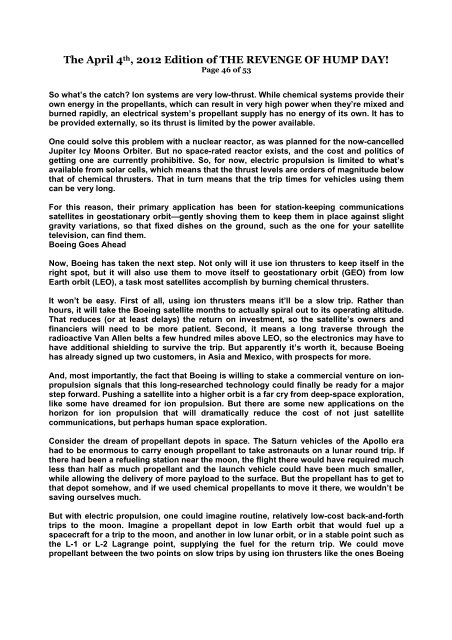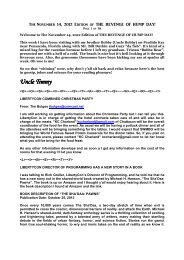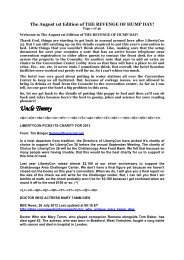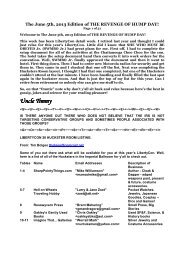Revenge of Hump Day 2012-04-04 - LibertyCon
Revenge of Hump Day 2012-04-04 - LibertyCon
Revenge of Hump Day 2012-04-04 - LibertyCon
- No tags were found...
Create successful ePaper yourself
Turn your PDF publications into a flip-book with our unique Google optimized e-Paper software.
The April 4 th , <strong>2012</strong> Edition <strong>of</strong> THE REVENGE OF HUMP DAY!Page 46 <strong>of</strong> 53So what’s the catch? Ion systems are very low-thrust. While chemical systems provide theirown energy in the propellants, which can result in very high power when they’re mixed andburned rapidly, an electrical system’s propellant supply has no energy <strong>of</strong> its own. It has tobe provided externally, so its thrust is limited by the power available.One could solve this problem with a nuclear reactor, as was planned for the now-cancelledJupiter Icy Moons Orbiter. But no space-rated reactor exists, and the cost and politics <strong>of</strong>getting one are currently prohibitive. So, for now, electric propulsion is limited to what’savailable from solar cells, which means that the thrust levels are orders <strong>of</strong> magnitude belowthat <strong>of</strong> chemical thrusters. That in turn means that the trip times for vehicles using themcan be very long.For this reason, their primary application has been for station-keeping communicationssatellites in geostationary orbit—gently shoving them to keep them in place against slightgravity variations, so that fixed dishes on the ground, such as the one for your satellitetelevision, can find them.Boeing Goes AheadNow, Boeing has taken the next step. Not only will it use ion thrusters to keep itself in theright spot, but it will also use them to move itself to geostationary orbit (GEO) from lowEarth orbit (LEO), a task most satellites accomplish by burning chemical thrusters.It won’t be easy. First <strong>of</strong> all, using ion thrusters means it’ll be a slow trip. Rather thanhours, it will take the Boeing satellite months to actually spiral out to its operating altitude.That reduces (or at least delays) the return on investment, so the satellite’s owners andfinanciers will need to be more patient. Second, it means a long traverse through theradioactive Van Allen belts a few hundred miles above LEO, so the electronics may have tohave additional shielding to survive the trip. But apparently it’s worth it, because Boeinghas already signed up two customers, in Asia and Mexico, with prospects for more.And, most importantly, the fact that Boeing is willing to stake a commercial venture on ionpropulsionsignals that this long-researched technology could finally be ready for a majorstep forward. Pushing a satellite into a higher orbit is a far cry from deep-space exploration,like some have dreamed for ion propulsion. But there are some new applications on thehorizon for ion propulsion that will dramatically reduce the cost <strong>of</strong> not just satellitecommunications, but perhaps human space exploration.Consider the dream <strong>of</strong> propellant depots in space. The Saturn vehicles <strong>of</strong> the Apollo erahad to be enormous to carry enough propellant to take astronauts on a lunar round trip. Ifthere had been a refueling station near the moon, the flight there would have required muchless than half as much propellant and the launch vehicle could have been much smaller,while allowing the delivery <strong>of</strong> more payload to the surface. But the propellant has to get tothat depot somehow, and if we used chemical propellants to move it there, we wouldn’t besaving ourselves much.But with electric propulsion, one could imagine routine, relatively low-cost back-and-forthtrips to the moon. Imagine a propellant depot in low Earth orbit that would fuel up aspacecraft for a trip to the moon, and another in low lunar orbit, or in a stable point such asthe L-1 or L-2 Lagrange point, supplying the fuel for the return trip. We could movepropellant between the two points on slow trips by using ion thrusters like the ones Boeing







